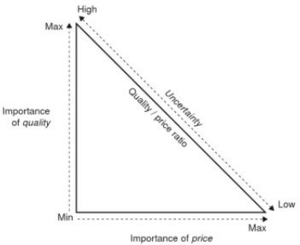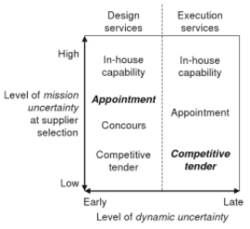Competitive tendering
Contents |
Abstract
This article is about competitive tendering which is the most commonly way for a client to procure construction services. Procurement is important because of the principal/agent problem where the client has to choose those who are appropriate, competent and trustworthy. This leads to the lemon problem which attends the problem regarding asymmetry of information.
Competitive tendering is a way to form the project coalition by making a set of codified documents that suppliers can make a bid on to offer their construction services. From the respond the client can then choose the most suitable contractor or supplier.
There are different things for the client to consider when making a tender. The first to consider is whether the selection criteria should be based on lowest price or best value. The second thing to consider is whether the bidding should be open to everyone, based on a tender list or based on a background of prequalification. The client can choose the option to make the tendering a two-stage tendering and/or if it should be a sealed bid action.
All these decisions and in overall the choice of competitive tendering as the procurement has both advantages and disadvantages.
The appropriate procurement is often based on a function of the two variables; the level of mission uncertainty and the phase in the project life cycle. The lower the levels of mission and dynamic uncertainty, the more appropriate the use of competitive tender becomes.
A big part of setting up the competitive tendering is the compliance with valid legislations within the area.
Big idea
Competitive tendering is the most commonly way for the clients to procure construction services.
The procuring phase is important to attend the principal/agent problem where the problem is asymmetry of information. The asymmetry generates two main problems which is the moral hazard and the adverse selection. Here is the problem of the adverse selection, also called “the lemon problem”, engaged to insure that the client hires competent suppliers of construction services. When asymmetry in information is high the poor-quality goods will drive out the better-quality goods in the market. This is especially the case in construction due to the high levels of uncertainty and is highest in the early stages of the project. Another purpose of competitive tendering is for the client to get a lower price and the competition in the building marked is kept sharp and motivated to the project.
Alternatives to the competitive tendering in procuring construction services are mainly In-house capability, appointment and concours (these not attended in this article).
Application
To form the project coalition by competitive tendering, the client first issues a codified set of documents which provides a detailed description of the construction service that has to be performed.
The presented documents allow the suppliers to calculate a price and proposal for supply of the services. On basis of the respond from the suppliers the client can then choose the most favorable.
A way to reduce the resource consumption in the procurement phase is to use a pre-qualification process which is often used in tendering of construction services. This process reduces the amount of tenders that has to spend time and money to make a tender and then reduces the resources for the client to go through them all.
In connection to pre-qualification the incoming applications goes through an evaluation in four steps. The first step is the exclusion which is made of a mandatory exclusion stated by the directives and the procurement act. This is e.g. if a tender is convicted of some criminal acts, has laundering money or made bribery. The other part is the voluntary exclusion where the client can make non-obligational execution of tenders. The execution reasons has however to be equal for all tenders and can e.g. be based on bankruptcy or debt to the public. The second step is a suitability study where it is controlled if the tenders meet the minimum criteria for economy and technical capacity and if the right documents have been submitted. The third step is a qualitative selection to obtain the most qualitative tenders for the specific service. If there still are too many tenders after the qualitative selection then needed, a quantitative selection can be made as the fourth step. These selection criteria can be set as the client fits best. Important though is that it is stated which criteria the tenders has been chosen on in the contract notice.
The tendering criteria can be based on only lowest price. This is maybe not the best solution because when the criteria only is based on price it can lead to unrealistic low prices from the tenders which will influence on the quality of the work and contractors become more eager to engage in legal action to recover their losses. It is also more likely to results in a higher cost because of overrun in cost and time and the end result has a higher maintenance and operation cost which in the long run overall gives a higher cost.
Another way to procure tenders is by the best value procurement. This is a combination of quality and price criteria. The quality is often assessed on a scoring principle which asses area which the client finds important. The criteria can e.g. be supplier track record, qualifications of key project personnel, reference and proposed approach to the problem. The score of the different criteria along with the price is then used to determine the value of the proposal. The quality to price ratio is important and varies with the level of uncertainty of the project. This is illustrated in Fig. 1.
For clients in the private sector an alternative is just to obtain prices from a number of contractors which is chosen by the client. Often the tendering is executed with a sealed bid auction to insure that every tender gives there best realistic bid and not just gives an offer that lies under the other competitors.
If the client is pressed on schedule or the project requires early contractor involvement it could be an option to make a two-stage tendering. Two-stage tendering is made first of a competitive bidding for the supply of project management typically covering detail design and execution on site. This will typically fix the most important decisions such as services needed and costs. The chosen preferred contractor is then organizing a competing tendering for the second tier of suppliers. The second stage helps to reduce the uncertainty within the project. Some of the advantages of two-stage tendering is the speed of procurement and the early involvement of the contractor. A problem with the method is though that the client is looked to the contractor after stage one but the contractor is not looked to the client, who could walk away if the client is too tough in the second stage of contracting.
Limitations
An important thing is to know when to use competitive tendering compared to some of the other procurement methods.
Alternatives to competitive tendering are e.g. maintain an in-house capability, appoint a supplier or launch a concours.
The base selection of a procurement form is a function of the level of uncertainty in the specification of the resource required at the time of selection. Two main interaction dimensions to take into account when choosing. One is the level of mission uncertainty then the supplier is selected and the other is the phase in the project life cycle where often the level of dynamic uncertainty has been reduced from the start of the project. The relationship between these two factors and the supplier selection method are illustrated in Fig. 2, the method in bold are the most common method in each phase.

